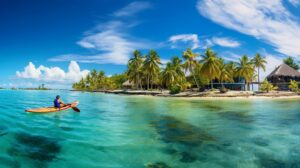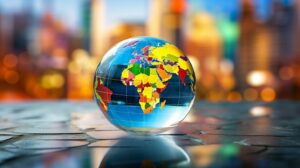Have you ever wondered which country a particular place is in? Whether you’re planning a trip, researching a location, or simply curious about the world around you, finding accurate information about a country’s location is crucial. In this section, we will explore different methods and tools to help you determine the country a specific place belongs to. From country locators to identification techniques, we’ve got you covered.
Key Takeaways:
- Country locators and search tools can help you find accurate country locations.
- Language, culture, landmarks, and geographic characteristics are useful in identifying a country.
- Country maps and boundaries provide insights into a nation’s territory.
- Exploring different countries and cultures enhances your understanding and appreciation.
- Researching a country’s location is important for travel planning and general knowledge.
Country Locator Tools
Country locator tools offer a convenient way to find the exact position of a country on a map or identify the country a particular location is in. Whether you are planning a trip, researching global demographics, or simply curious about a specific place, these tools can provide accurate and detailed information.
One popular country locator tool is the GeoNames website. It allows users to search for a country by entering the name of a city, landmark, or any recognizable location. The search results include the country name along with its two-letter abbreviation, providing a quick and easy way to determine the country a location belongs to.
Another useful tool is Google Maps, which not only allows you to locate countries on a map but also provides additional information about the selected country. By simply typing the name of a country in the search bar, you can explore its borders, neighboring countries, and even find interesting landmarks within the country.
Table: Examples of Country Locator Tools
| Tool | Features |
|---|---|
| GeoNames | Search by city, landmark, or location |
| Google Maps | Interactive maps with additional information |
| MapQuest | Geolocation services for accurate results |
These are just a few examples of the many country locator tools available online. They are user-friendly, accessible from any device with an internet connection, and provide valuable information about countries around the world. So next time you need to locate a country or identify the country a specific location is in, give these tools a try and enhance your knowledge of the world.
Country Identification Methods
When it comes to identifying a country, there are various methods and factors that can be taken into account. From language and culture to landmarks and geographical characteristics, each plays a significant role in determining the country a particular location belongs to. Let’s explore some of the common methods used for country identification.
Language
Language is often a crucial factor in determining the country a location is in. Each country has its own official language(s) or regional languages that are predominantly spoken. For example, English is widely spoken in the United States, while Spanish is the primary language in Mexico. By considering the language spoken in a specific area, you can narrow down the possible countries it could belong to.
Culture
Cultural aspects such as traditions, customs, and festivals can also provide valuable clues for country identification. Each country has its unique cultural practices and celebrations. For instance, if you come across a location where people celebrate Diwali with grandeur, it is likely to be in India, where the festival originated. Observing the cultural manifestations of a place can help narrow down the potential country it is associated with.
Landmarks and Geographical Characteristics
Landmarks and geographical characteristics are often recognizable symbols of a country. Famous landmarks like the Statue of Liberty in the United States or the Eiffel Tower in France are instantly associated with their respective countries. Similarly, geographical features like mountains, rivers, or coastlines can provide geographical context, aiding in country identification. By studying these landmarks and geographical characteristics, you can gain insights into the country a location is located in.
In summary, identifying a country involves considering various factors such as language, culture, landmarks, and geographical characteristics. By examining these elements, you can determine the country a specific location belongs to. Whether it’s through language analysis, cultural observation, or studying prominent landmarks, each method contributes to a comprehensive understanding of country identification.
| Country | Language | Cultural Aspects | Landmarks |
|---|---|---|---|
| United States | English | Diverse cultural practices | Statue of Liberty, Grand Canyon |
| France | French | Fashion, cuisine, art | Eiffel Tower, Louvre Museum |
| India | Hindi, English | Vibrant festivals, spirituality | Taj Mahal, Red Fort |
| Mexico | Spanish | Colorful traditions, mariachi music | Chichen Itza, Tulum |
Country Maps and Boundaries
Country maps and boundaries play a crucial role in visualizing and comprehending the geography and territories of different nations. These maps provide detailed information about a country’s land area, borders, and neighboring countries. They are essential tools for researchers, travelers, and even everyday individuals who want to explore and understand the world better.
Maps offer a visual representation of a country’s geographical features, including mountains, rivers, and coastlines, allowing us to appreciate the diverse landscapes and natural wonders each nation possesses. They also depict political boundaries, which define a country’s territorial limits and demarcate the areas under its governance.
| Country | Abbreviation |
|---|---|
| United States | US |
| Canada | CA |
| United Kingdom | UK |
By examining country maps, we can gain a better understanding of a nation’s cultural, social, and political divisions. Maps provide insights into the distribution of cities, towns, and rural areas, enabling us to grasp the population density and settlement patterns within a country.
Moreover, understanding a country’s boundaries is crucial for geopolitical analysis and international relations. It helps us recognize the shared borders between neighboring nations, facilitating diplomatic discussions, trade agreements, and cooperative initiatives.
Conclusion
In conclusion, country maps and boundaries offer a wealth of information about a nation’s geography, territories, and political structures. They allow us to visualize the world in a more comprehensive manner, appreciate the diversity of landscapes, and comprehend the complex relationships between countries. Whether you’re an avid traveler or simply curious about the world, exploring country maps is an excellent way to deepen your knowledge and broaden your perspective.
Exploring Countries and Cultures
Embark on a journey of exploration as we delve into the fascinating countries and cultures that make our world so rich and diverse. From the bustling cities of the United States to the serene landscapes of Japan, each country holds its own unique charm and allure. Whether you are a seasoned traveler or simply curious about the world, there is always something new to discover.
One of the most exciting aspects of exploring different countries is immersing oneself in their cultures. Every country has its own traditions, customs, and way of life that contribute to its distinct identity. By delving into these cultural aspects, we gain a deeper understanding of the people who call a particular country home. From sampling local delicacies to participating in traditional festivals, these experiences allow us to connect with a country’s history and heritage in a meaningful way.
Country search tools can also enhance our exploration by providing valuable insights and information. Whether you are planning a trip or simply interested in learning more about a country, these tools can help you navigate through the vast array of options. With just a few clicks, you can uncover hidden gems, discover popular attractions, and gain a deeper appreciation for the country you are researching.
As we embark on this journey together, let us celebrate the diversity of our world and the richness of each country’s culture. By exploring countries and immersing ourselves in their unique traditions and customs, we not only expand our horizons but also foster a greater sense of global unity. So, join me as we embark on this exciting adventure and unlock the wonders of the world, one country at a time.
FAQ
Q: What is a country locator tool?
A: A country locator tool is an online tool that helps you find the position of a country on a map or determine the country a specific location belongs to. It allows you to search for countries based on various criteria, such as name, coordinates, or address.
Q: How do I use a country locator tool?
A: To use a country locator tool, simply enter the desired criteria, such as the name of the location or its coordinates, into the search bar provided by the tool. The tool will then display the corresponding country or its position on the map.
Q: What are some popular country locator tools?
A: Some popular country locator tools include Google Maps, MapQuest, Geonames, and World Atlas. These tools provide comprehensive mapping and country search functionalities, making it easy to find accurate country locations.
Q: What are the different methods to identify a country?
A: There are various methods to identify a country, including language analysis, cultural examination, landmark recognition, and geographical characteristics. These methods can help determine the country a location belongs to based on specific attributes or features associated with that country.
Q: Why are country maps and boundaries important?
A: Country maps and boundaries are important for understanding the geographical layout and territorial limits of a specific nation. They provide valuable insights into a country’s land area, neighboring countries, and political divisions, helping to establish a clear understanding of its geographic context.
Q: How can I explore different countries and cultures?
A: To explore different countries and cultures, consider traveling to new destinations, immersing yourself in the local customs and traditions, and engaging with the local community. You can also enhance your understanding by researching about the country’s history, art, cuisine, and other cultural aspects.



